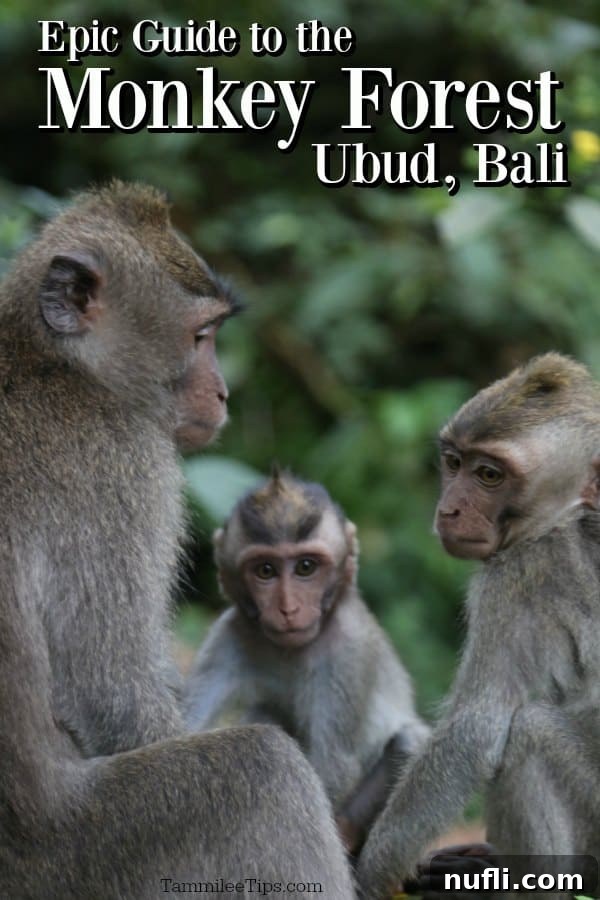Welcome to the captivating world of the Ubud Monkey Forest, one of Bali’s most iconic and enchanting attractions! This guide offers comprehensive travel tips for visiting the Sacred Monkey Forest Sanctuary, ensuring you have an unforgettable and safe experience amidst its lush greenery and playful long-tailed macaques. Whether you’re planning your first trip or looking for updated insights, discover everything you need to know about this spiritual and ecological haven.
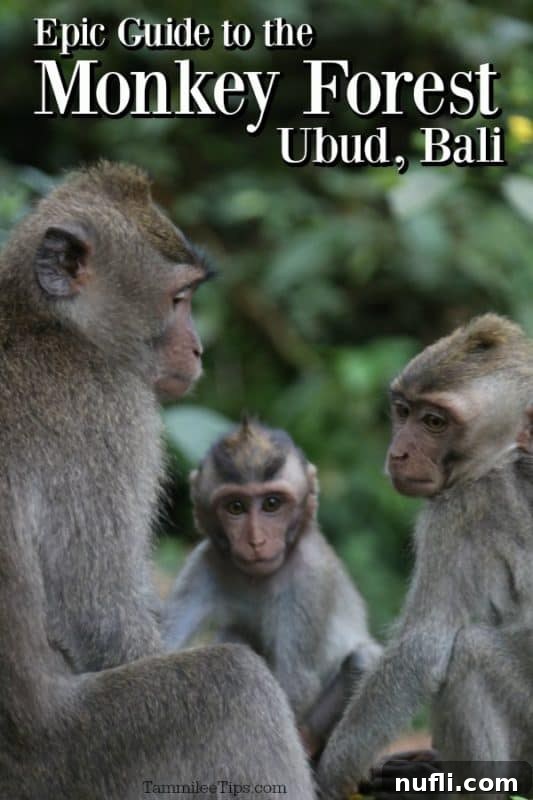
Quick Travel Essentials for Ubud Monkey Forest:
Planning your Bali adventure? Here are immediate resources for a seamless trip:
🏨Find the Best Hotels and Vacation Rentals in Ubud
📍Book Exciting Tours and Activities Near Monkey Forest
Ubud Monkey Forest: Your Ultimate Guide to an Unforgettable Bali Adventure
Stepping into the Sacred Monkey Forest Sanctuary in Ubud was, for me, an experience laced with both profound excitement and a healthy dose of apprehension. Prior to our Bali trip, I immersed myself in countless blogs and guides, hoping to arm myself with every possible piece of advice on how to navigate this renowned attraction. What I gathered from my research painted a picture of mischievous macaques, capable of incredible feats, making me half-expect a primate to launch itself onto my head at any moment! Thankfully, my fears were largely unfounded, and my visit turned out to be one of the absolute highlights of our Bali journey. While I did witness a startling incident of a monkey jumping on another guest, it served as a vivid reminder of the importance of preparedness and respectful engagement.
My successful, incident-free visit, I believe, boiled down to two crucial factors: a good measure of common sense and a strict policy of keeping all food and drink out of sight. This includes being mindful of others, even local staff, who might be carrying tempting items. The monkeys are incredibly intelligent and opportunistic, making awareness your best defense against unwanted attention. The vibrant energy and playful antics of the monkeys, set against the backdrop of an ancient forest, create a dynamic atmosphere unlike any other. Every turn offers a new scene, from a mother grooming her baby to a group of youngsters wrestling playfully. It’s this unpredictability that makes the Monkey Forest so captivating.
Discover a wide array of fascinating tours and activities in and around the Ubud area, including visits to the Monkey Forest HERE.
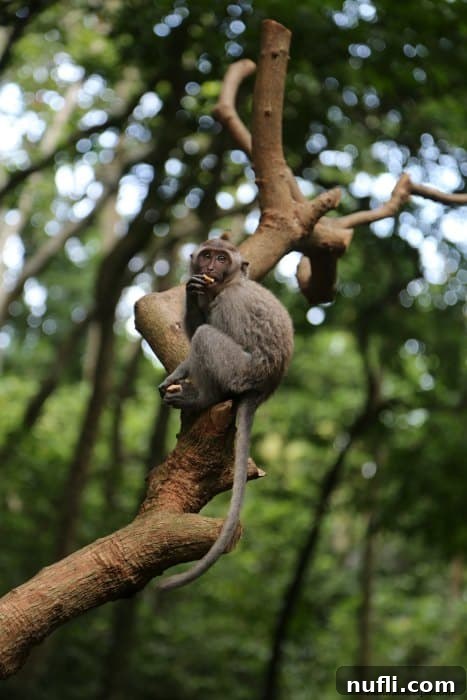
Essential Tips for a Safe and Enjoyable Visit to Ubud Monkey Forest
To ensure your experience at the Sacred Monkey Forest Sanctuary is both memorable and safe, it’s paramount to understand the behavior of the long-tailed macaques and follow a few key guidelines. These creatures are wild animals, and while generally accustomed to humans, they are driven by instinct, especially when it comes to food. Our visit was entirely free of issues because we came prepared and adhered strictly to the sanctuary’s recommendations, ensuring we had no food or water bottles visible or accessible.
The Golden Rule: No Food, No Water Bottles
The most critical piece of advice I can offer is to meticulously clean out your bag or purse before entering the Monkey Forest. Monkeys possess an incredibly keen sense of smell and can detect food even if it’s sealed away in your belongings. This includes everything from candy, gum, and snacks to fruit and even unopened water bottles. We witnessed monkeys skillfully snatching water bottles from unsuspecting tourists, unscrewing the caps, and enjoying their contents with surprising dexterity. They are also known to grab sunglasses, hats, or other loose items in hopes of a “ransom” – often a banana in exchange for your retrieved possession.
Save yourself the potential stress and inconvenience of a monkey attempting to delve into your bag. A thorough check beforehand, ensuring all food and drink items are left outside the sanctuary (perhaps in your hotel or a locker if available), will make a significant difference. This simple precaution dramatically reduces the chances of an unwanted interaction and allows you to enjoy the forest’s beauty without constant vigilance over your belongings.
Interacting Responsibly: What to Do and What to Avoid
While feeding the monkeys can seem like a fun interaction, it’s best left to the professionals. Vendors on-site sell bananas specifically for feeding, and they know how to manage the interaction safely. If you choose to feed them, do so only with bananas purchased from these authorized vendors and follow their instructions. Avoid bringing your own food, as this can lead to aggressive behavior when the monkeys expect a treat but don’t receive one. We decided against feeding them ourselves, as managing our bags and camera felt like enough responsibility without adding hungry monkeys into the mix. There were plenty of opportunities to observe others feeding them, providing a great understanding of the dynamic without direct involvement.
Crucially, never taunt or tease the monkeys with food. We observed a tourist holding a banana out to a monkey, only to pull it away repeatedly. The monkey’s reaction was immediate and clear: baring its teeth, it communicated its displeasure in no uncertain terms. While no physical harm occurred, it highlighted how quickly a playful interaction can turn tense when boundaries are crossed. Respect their space, avoid direct eye contact if they seem agitated, and remember they are wild animals, not pets.
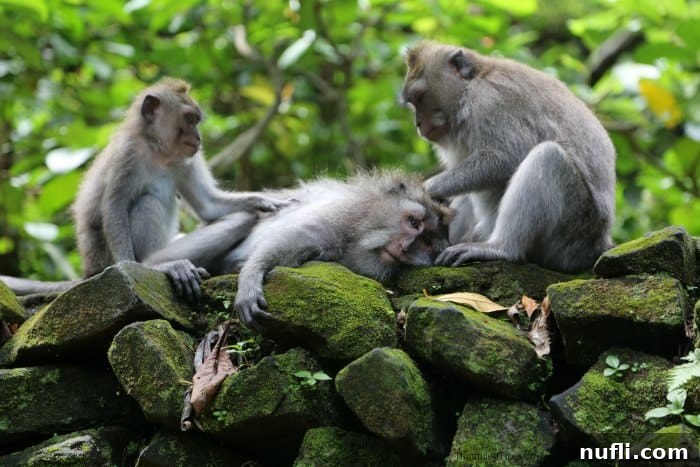
Discovering the Heart of Ubud Monkey Forest
From the moment we stepped foot into the Ubud Monkey Forest, we were enveloped in a vibrant ecosystem bustling with life. Monkeys were everywhere – gracefully leaping through the ancient trees, confidently striding along the pathways, perched regally on ornate statues, and even cheekily attempting to snatch bananas from vendors. There’s no doubt you’ll encounter numerous macaques throughout your visit, making for fantastic photo opportunities and memorable observations.
Beyond the Monkeys: Lush Landscapes and Sacred Sites
The Ubud Monkey Forest is far more than just a home for its primate residents; it is a sprawling, sacred sanctuary that beautifully intertwines nature, culture, and spirituality. The forest itself is a stunning natural wonder, much larger than I had anticipated. Towering nutmeg trees create a dense canopy, filtering sunlight into dappled patterns on the forest floor. Ancient banyan trees with their sprawling roots add to the mystical atmosphere, making it easy to spend an hour or two simply wandering and soaking in the tranquil environment.
As you explore, you’ll encounter intricately carved stone statues, moss-covered sculptures, and ancient Hindu temples that are integral to the sanctuary’s spiritual significance. These temples, such as the Pura Dalem Agung Padangtegal (main temple), Pura Beji (bathing temple), and Pura Prajapati (cremation temple), are active places of worship for the local community and add a profound sense of sanctity to the forest. While visitors are generally not permitted inside the holiest parts of the temples, their exterior architecture and surroundings are incredibly beautiful and offer insight into Balinese Hindu traditions.
Exploring the Multi-Level Sanctuary
The sanctuary’s terrain is quite diverse, featuring multiple levels and areas to explore. Be prepared for uneven ground, winding paths, and a good number of steps, particularly leading down to the lower sections. One of the most captivating areas lies at the bottom of a series of 20 to 40 steps, where a serene walk along a flowing waterway awaits. This lower level is a verdant paradise, abundant with beautiful plants, cascading vines, and ancient bridges that cross the stream. While you might encounter fewer monkeys in this specific section, its natural beauty, tranquility, and the presence of the sacred bathing temple make it a must-visit. It’s a wonderful place to escape the main crowds and appreciate the forest’s ecological richness.
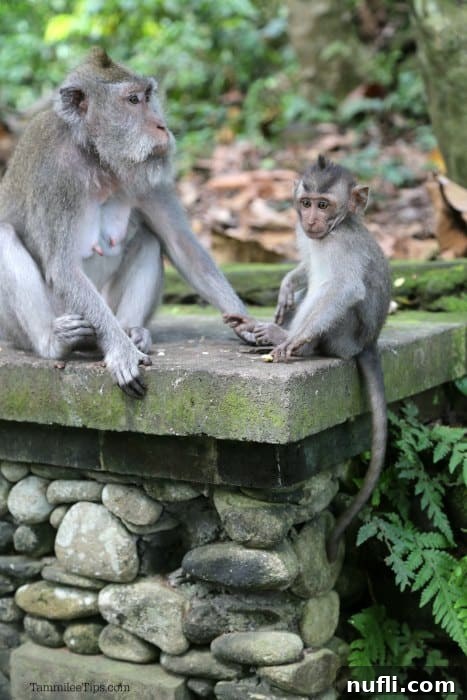
The Joy of Observation: Baby Monkeys and Family Dynamics
One of the most heartwarming aspects of our visit was observing the countless baby monkeys. Having recently watched Disneynature’s Monkey Kingdom, I found myself constantly drawing parallels to the film, marveling at the intricate social structures and family dynamics playing out before my eyes. The Monkey Forest offers an unparalleled opportunity to witness these interactions firsthand: mothers tenderly caring for their young, juveniles playfully chasing each other through the branches, and older, more dominant males asserting their presence.
It was fascinating to observe the subtle (and sometimes not-so-subtle) cues that revealed which monkeys ruled the roost. The macaques live in distinct groups, and you can often see them grooming each other, a vital social activity that strengthens their bonds. The majority of monkeys simply coexist peacefully, meandering through the temple grounds. However, due to their ubiquitous presence, it’s always wise to watch your step to avoid accidentally disturbing them or stepping on one.
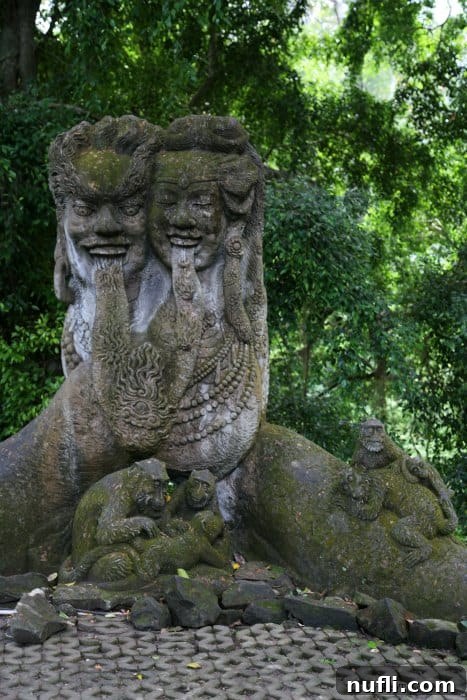
Planning Your Visit: Practical Information for Ubud Monkey Forest
A visit to the Sacred Monkey Forest Sanctuary (Mandala Suci Wenara Wana) is a must for anyone exploring Ubud, Bali. Known for its population of long-tailed macaques (Macaca fascicularis) and its spiritual significance as a Balinese Hindu site, the sanctuary offers a unique blend of nature, wildlife, and culture. Here’s what you need to know for a smooth and rewarding experience.
Entrance Fees and Opening Hours
There is a small entrance fee to enter the Monkey Forest, which helps with the upkeep of the sanctuary and the welfare of the monkeys. You can typically pay cash at the gate. Check the official Monkey Forest website or local guides for the most current pricing and opening hours, as these can occasionally change. Arriving early in the morning, shortly after opening, or later in the afternoon can often mean fewer crowds and more active monkeys.
What to Wear and Bring
Comfortable walking shoes are highly recommended, as you’ll be navigating uneven paths, steps, and possibly slippery surfaces, especially after rain. Dress respectfully, as you are entering a sacred site; while a sarong isn’t strictly required for the Monkey Forest itself (unlike some other temples), modest attire is always appreciated in Bali. Bring your camera to capture the stunning scenery and playful monkeys, but ensure it’s securely held. It’s best to leave any unnecessary valuables at your accommodation to minimize the risk of loss or theft by opportunistic macaques.
Secure Your Belongings
Beyond food and water, monkeys are attracted to shiny objects and anything that looks interesting or easy to grab. It is highly advisable to place sunglasses, hats, jewelry, and any other loose items deep inside your bag or in a secure, sealed pocket. Avoid carrying open bags or dangling items that are easily accessible. We were advised that monkeys sometimes steal items not necessarily for food, but perhaps out of curiosity or habit, and may only release them if offered a banana in return. Being proactive in securing your items will prevent potential hassles and allow you to fully immerse yourself in the experience.
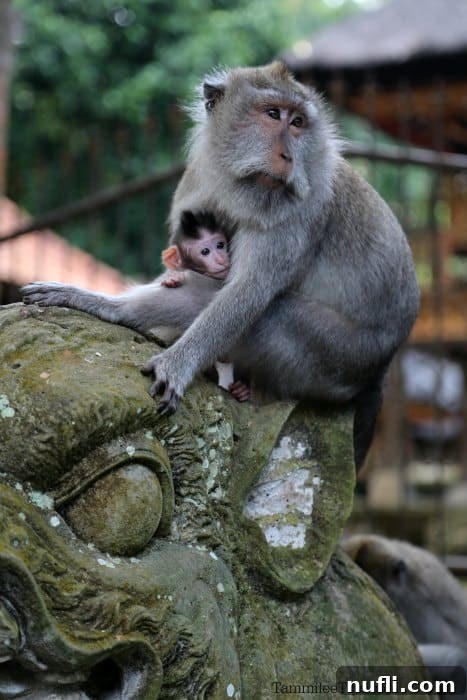
Why Ubud Monkey Forest is a Must-Visit in Bali
The Ubud Monkey Forest offers more than just a chance to see monkeys; it provides a unique cultural and ecological immersion. It’s a place where ancient traditions, dense tropical nature, and captivating wildlife converge. The sanctuary is not just a tourist attraction but a vital center for research and conservation, playing a significant role in the local ecosystem and the spiritual life of the Padangtegal community. Visitors leave with a deeper appreciation for nature’s delicate balance and the fascinating world of these intelligent primates.
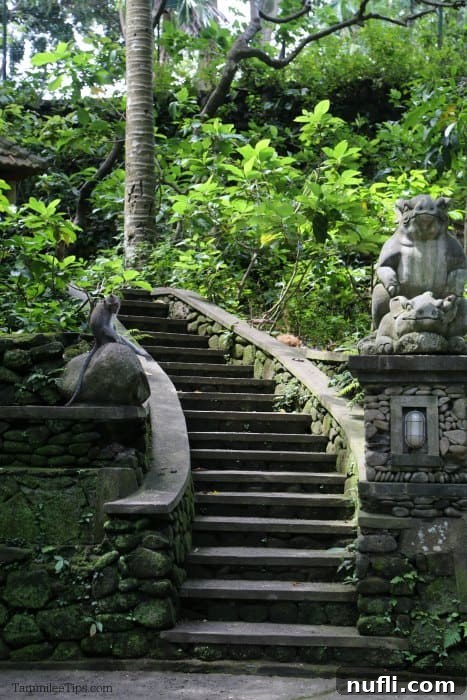
Beyond the Forest: Discover More Bali Travel Resources
Bali is an island of endless wonders. After experiencing the magic of the Ubud Monkey Forest, consider exploring these other incredible destinations and insights to enrich your Balinese adventure:
A Unique Experience at Ubud Starbucks
Captivating Sunset at Tanah Lot Temple
Exploring Bali’s UNESCO Rice Terraces
Comprehensive Bali Travel Tips
A Creepy Yet Cool Visit to Bali’s Bat Cave
The Ultimate Guide to Bali Travel Book
Don’t forget to check out all of our Bali Travel Articles for more inspiration and planning advice for your dream vacation!
